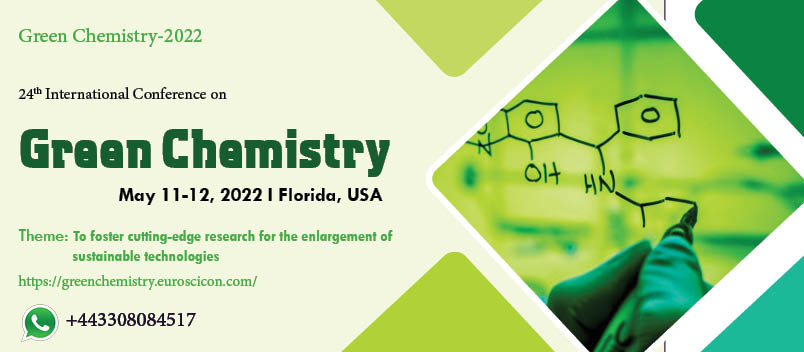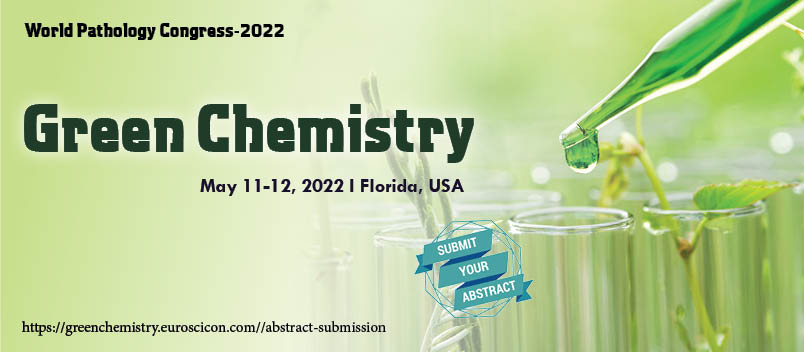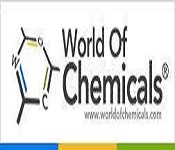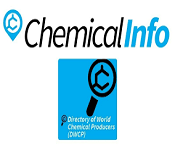GREEN-CHEMISTRY-2022
ABOUT CONFERENCE
EuroSciCon invites all the participants from all over the world to attend “24th International Conference on Green Chemistry-2022’’ during May 11-12, 2022, at Florida, USA. Which includes prompt keynote presentations, Oral talks, Poster presentations, Workshops and Exhibitions.
Green Chemistry -2022 is a global overview the Theme: “To foster cutting-edge research for the enlargement of sustainable technologies” is designed for professionals at all levels and career phases of the Chemical industry, Pharmaceutical industry and Petroleum industry, who want to improve their understanding of what will drive and shape the future of the market. This will include senior executives, sales and marketing personnel, strategic planners, who will be benefit from a broad overview of the Chemical, Pharmaceutical and petroleum industry. The strength of the Conference is that the participants tend to include all phases of the value chain as well as individuals from a wide variety of sector and countries. This experience helps the conference to be an interactive forum and encourages a strong level of dialogue and discussion, thus maximising the benefits of attendance. This conference surely provides better information and insight into the development of the world Chemical industry, which in turn has enabled attendees to make better and more profitable decisions.
Why to attend our Conference
It promotes the positive contributions of Green Chemistry by:
Highlighting the material and chemicals beneficial Physical and chemical properties and its positive contributions to society throughout its life cycle
Providing society with educational information to help raise awareness and correct misconceptions
Liaising with European and national institutions in policy matters to secure decisions based on accurate information
Communicating plastics contribution to sustainable development, innovation and quality of life
Initiating in depth studies and sharing experiences.
Target Audience for Green Chemistry -2022
Eminent Scientists/ Research Professors in the field of Green Chemistry, Chemical, Pharmaceutical, Toxicology, Polymer and petroleum, Junior/Senior research fellows, Students, Directors of Chemical research companies, Chemical Engineers, Members of Chemistry associations and exhibitors from Chemical, Pharmaceutical, Petroleum and Polymer Industry/Plastic Industries.
About City
Florida is the south easternmost U.S. state, with the Atlantic on one side and the Gulf of Mexico on the other. It has hundreds of miles of beaches. The city of Miami is known for its Latin-American cultural influences and notable arts scene, as well as its nightlife, especially in upscale South Beach. Orlando is famed for theme parks, including Walt Disney World.
Attraction & Landmark
- John Knox House
- The Royal Mile
- Edinburgh Castle
- St Giles' Cathedral
- Holyrood Park
- The Royal Botanic Garden
- National Museum of Scotland
- The National Galleries of Scotland
- National Library of Scotland
- Greyfriars Church
- The Museum of Childhood
- Rosslyn Chapel
- Forth Bridge
- Edinburgh Zoo
SESSIONS AND TRACKS
Green Chemistry is a type of chemical research and engineering. It is the design of chemical products and processes that reduce or eliminate the use or generation of hazardous substances. Green Chemistry applies across the life cycle of a chemical product, including its design, manufacture, use, and ultimate disposal. Green chemistry is also known as sustainable chemistry. Green chemistry aims to design and produce cost-competitive chemical products and processes that attain the highest level of the pollution-prevention hierarchy by reducing pollution at its source. Remediation may include separating hazardous chemicals from other materials, then treating them so they are no longer hazardous or concentrating them for safe disposal. Most remediation activities do not involve green chemistry. Remediation removes hazardous materials from the environment. On the other hand, green chemistry keeps the hazardous materials out of the environment in the first place. Green chemistry is the use of chemistry for pollutant source reduction. Therefore, all aspects of chemical processes that reduce impact on human health and on the environment. Its goal is to improve the quality of life and the competitiveness of industry by encouraging the design of products and processes that reduce or eliminate the use and generation of hazardous substances, For example by developing alternative syntheses for important industrial chemicals.
Track 1: Green Chemistry In Pharmaceutical Industries
Green chemistry is being employed to develop revolutionary drug delivery methods that are more effective and less toxic and could benefit millions of patients. Phosphoramidite-based, solid-phase synthesis of antisense oligonucleotides has been modified to accommodate principles of green chemistry by eliminating the use and generation of toxic materials and allowing reuse of valuable materials such as amidites, solid-support and protecting groups, thus improving the atom economy and cost-efficiency.
Track 2: Analytical Methods In Green Chemistry
The growing interest in green chemistry requires fresh perspectives on analytical extractions. Reduced solvent consumption, alternative safer solvents, and reasonable energy demands must be balanced with traditional analytical considerations such as extraction yield and selectively. This session deals with some of the concepts behind green chemistry and discusses green solvent selection and extraction techniques. An overview of alternatives to conventional solvents, new green solvents, ionic liquids, and other solvent options will be discussed in this scientific discussion.
Track 3: Applications Of Green Chemistry And LCA
Polysaccharides polymers: These are biological feedstock, and as such have the advantage of being renewable, as opposed to those feedstocks which are the product of petroleum. On the other hand, these have no chronic toxicity to human health and environment. Commodity chemicals from glucose: glucose is another alternative for commodity chemicals by using glucose in place of benzene, can help in minimizing the use of certain reagents with certain toxicity. The conduction of synthesis in water instead of organic solvents is more beneficial. The use of CO2 as a substitute for organic solvents already represents a tool of waste reduction in chemical industry.
Track 4: Biodegradation
Biodegradation is nature’s waste management and recycling system. It breaks down everything from yard waste to crude oil. It is a natural process necessary to keep our planet clean and healthy. “A process by which microbial organisms transform or alter (through metabolic or enzymatic action) the structure of chemicals introduced into the environment.” Basically, organic (carbon-based) material is changed through chemical processes from complex molecules into simpler molecules, eventually returning the molecules into the environment. For example, a banana peel can be reduced from cellulose to water, carbon dioxide gas, and humus in a compost pile.
Track 5: Biomass & Bioenergy
Biomass is an energy resource derived from plant- and algae-based material that includes crop wastes, forest residues, purpose-grown grasses, woody energy crops, algae, industrial wastes, sorted municipal solid waste, urban wood waste, and food waste. Biomass is the only renewable energy source that can offer a viable supplement to petroleum-based liquid transportation fuels—such as gasoline, jet, and diesel fuel in the near to mid-term. It can also be used to produce valuable chemicals for manufacturing, as well as power to supply the grid. A collaborative and multidisciplinary in-depth analysis by the U.S. Department of Energy determined that the United States has the capacity to sustainably produce over 1 billion tons of biomass annually—and still meet demands for food, feed, and fiber. Bioenergy is renewable energy made available from materials derived from biological sources. Biomass is any organic material which has stored sunlight in the form of chemical energy. As a fuel it may include wood, wood waste, straw, manure, sugarcane, and many other by-products from a variety of agricultural processes. Bioenergy is one of the many diverse resources available to help meet our demand for energy. It is classified as a form of renewable energy derived from biomass organic material that can be used to produce heat, electricity, transportation fuels, and products.
Track 6: Biopolymer & Bioplastics
Biopolymers are polymers synthesized by living organisms. Biopolymers can be polynucleotides (such as the nucleic acids DNA and RNA), polypeptides (that is, proteins) or polysaccharides (that is, polymeric carbohydrates). This consist of long chains made of repeating, covalently bonded units, such as nucleotides, amino acids or monosaccharides. Bioplastic is a biodegradable material that come from renewable sources and can be used to reduce the problem of plastic waste that is suffocating the planet and polluting the environment. As an alternative, the use of bioplastics is being promoted, consisting in obtaining natural polymers from agricultural, cellulose or potato and corn starch waste. These are 100% degradable, equally resistant and versatile, already used in agriculture, textile industry, medicine and, over all, in the container and packaging market, and biopolymers are already becoming popular in cities throughout Europe and the United States for ecological reasons: they are known as PHA.
This product is expected to cover the needs of 10% of the European plastics market within 10 years.
They reduce carbon footprint
They are providing energy savings in production
They do not involve the consumption of non-renewable raw materials
Their production reduces non-biodegradable waste that contaminates the environment
They do not contain additives that are harmful to health, such as phthalates or bisphenol A
They do not change the flavor or scent of the food contained
Track 7: Eco Friendly Materials
Eco-friendly literally means earth-friendly or not harmful to the environment. This term most commonly refers to products that contribute to green living or practices that help conserve resources like water and energy. Eco-friendly products also prevent contributions to air, water and land pollution. You can engage in eco-friendly habits or practices by being more conscious of how you use resources. Eco Friendly are sustainability and marketing terms referring to goods and services, laws, guidelines and policies that claim reduced, minimal, or no harm upon ecosystems or the environment. Companies use these ambiguous terms to promote goods and services, sometimes with additional, more specific certifications, such as ecolabels. Their overuse can be referred to as greenwashing
Track 8: Future Trends In Green Chemistry
VOC reduction enables better indoor and outdoor air quality, and decreases human exposure to pollutants, Dow’s low-or no-VOC solutions cost less than more traditional compounds, Dow’s low or no-VOC solutions meet sustainability requirements without compromising the quality of the product.The manufacture of computer chips requires excessive amounts of chemicals, water, and energy. Estimates indicate that the weight of chemicals and fossil fuels required to make a computer chip is 630 times the weight of the chip, as compared to the 2:1 ratio for the manufacture of an automobile.
Track 9: Green Catalysis
Catalysis has come a long way and has served industry well in enabling many reactions to be done which, otherwise, would have been uneconomic or even impossible. Today chemists are faced with new challenges as concerns for the environment and scarcity of resources motivates them to look for greener processes. Biocatalysis is the main green chemistry technology adopted by the fine chemicals and pharmaceutical industries to manufacture chemicals with higher yield. Heterogeneously catalyzed processes using supported metal or molecular catalysts are still an exception.
Track 10: Green Chemistry
Green chemistry emerged from a variety of existing ideas and research efforts (such as atom economy and catalysis) in the period leading up to the 1990s, in the context of increasing attention to problems of chemical pollution and resource depletion. The development of green chemistry in Europe and the United States was linked to a shift in environmental problem-solving strategies: a movement from command and control regulation and mandated reduction of industrial emissions at the "end of the pipe," toward the active prevention of pollution through the innovative design of production technologies themselves.
For a technology to be considered Green Chemistry, it must accomplish three things:
It must be more environmentally benign than existing alternatives.
It must be more economically viable than existing alternatives.
It must be functionally equivalent to or outperform existing alternatives.
Green Chemistry presents industries with incredible opportunity for growth and competitive advantage. This is because there is currently a significant shortage of green technologies: we estimate that only 10% of current technologies are environmentally benign; another 25% could be made benign relatively easily. The remaining 65% have yet to be invented! Green Chemistry also creates cost savings: when hazardous materials are removed from materials and processes, all hazard-related costs are also removed, such as those associated with handling, transportation, disposal, and compliance. Through Green Chemistry, environmentally benign alternatives to current materials and technologies can be systematically introduced across all types of manufacturing to promote a more environmentally and economically sustainable future.
Track 11: Green Chemistry & Sustainable Process
Green chemistry metrics serve to quantify the efficiency or environmental performance of chemical processes and allow changes in performance to be measured. The motivation for using metrics is the expectation that quantifying technical and environmental improvements can make the benefits of new technologies more tangible, perceptible, or understandable. This, in turn, is likely to aid the communication of research and potentially facilitate the wider adoption of green chemistry technologies in industry.
Track 12: Green Chemistry In Environment
Environmental science is the multidisciplinary study of all aspects of the Earth’s physical and biological environments. It encompasses environmental chemistry, soil science, ecology, climatology, vegetation cover, marine and freshwater systems, as well as environmental remediation and preservation, and agriculture and land use. It also covers topics like Environmental Chemistry, Carbon footprint, Co2 capture, Greenhouse effect and many more. The natural greenhouse effect is caused by greenhouse gases which occur naturally in the earth’s atmosphere. The main natural greenhouse gases are carbon dioxide (CO2), methane (CH4), nitrous oxide (N2O), and water (H2O). These gases absorb and re-radiate the sun’s heat, helping to warm the planet and providing a temperature range that is suitable for life as we know it. Without these natural greenhouse gases, the temperature of the earth’s atmosphere would be approximately 34 degrees Celsius lower than it is today.
Track 13: Green Chemistry In Industries
Chemical synthesis using biodegradable materials (bioplastics, biopolymers) and syntheses using biomass-derived building blocks, High atom economy synthesis, Solvent elimination and sustainability assessment of solvents, Utilization of techniques and technologies that minimize energy and maximize reaction efficiency. Biocatalysis is the main green chemistry technology adopted by the fine chemicals and pharmaceutical industries to manufacture chemicals with higher yield. Heterogeneously catalyzed processes using supported metal or molecular catalysts are still an exception
Track 14: Green Energy
Green chemistry also plays a key role in alternative energy science, and the production of new ways to make solar cells, fuel cells, and batteries for storing energy. According to a recent analysis, solar photovoltaic technology is “one of the few renewable, low-carbon resources with both the scalability and the technological maturity to meet ever-growing global demand for electricity.” The use of solar photovoltaics has been growing at an average of 43% per year since 2000. In recent years, clean energy experts have been very excited about the emergence of two new chemistry-driven solar technologies, perovskite solar cells and quantum dots.
Track 15: Green Engineering
Green engineering approaches the design of products and processes by applying financially and technologically feasible processes and products in a manner that simultaneously decreases the amount of pollution that is generated by a source, minimizes exposures to potential hazards (including reducing toxicity and improved uses of matter and energy throughout the life cycle of the product and processes) as well as protecting human health without relinquishing the economic efficiency and viability. As such, green engineering is not actually an engineering discipline in itself, but an overarching engineering framework for all design disciplines.
Green engineering is the design, commercialization, and use of processes and products in a way that reduces pollution, promotes sustainability, and minimizes risk to human health and the environment without sacrificing economic viability and efficiency. Green engineering embraces the concept that decisions to protect human health and the environment can have the greatest impact and cost-effectiveness when applied early, in the design and development phase of a process or product.
Principles of Green Engineering
Green engineering processes and products:
Holistically use systems analysis and integrate environmental impact assessment tools.
Conserve and improve natural ecosystems while protecting human health and well-being.
Use life-cycle thinking in all engineering activities.
Ensure that all material and energy inputs and outputs are as inherently safe and benign as possible.
Minimize depletion of natural resources.
Strive to prevent waste.
Develops and applies engineering solutions while being cognizant of local geography, aspirations, and cultures.
Creates engineering solutions beyond current or dominant technologies; improves, innovates, and invents (technologies) to achieve sustainability.
Actively engages communities and stakeholders in the development of engineering solutions.
Track 16: Green Environmental Toxicology
There are number of approaches that can be used to support chemical risk assessment. Ideally, predictive tools identify hazards to be avoided; for example, it may be possible to identify a compound property or structural features that are associated with adverse effects. Such computational tools that exploit existing toxicology information can be used to ascertain potential relationships between chemical space and toxicological response. The outputs from these analyses can be used to define project-specific, toxicology experiments to determine if the predicted toxicities are real and so influence compound design.
Track 17: Green Nanotechnology
There are several proposed remediation techniques that use nanotechnology. For example, solar photocatalysis using titanium dioxide nanoparticles can degrade pollutants like volatile organic compounds and nitrous oxides and consequently has been used in cement and commercial plants. Paints enriched with Nano titanium dioxide, replacing organic biocides, are used to keep the surfaces of buildings clean.Soil remediation of abandoned and old military and industrial sites has become a great challenge in industrialized nations. Trials have been set-up using Nano zero-valent iron and iron oxides and the results have been quite promising. However, there are environmental concerns regarding the impact of nanoparticles on the soil.
Track 18: Green Organic Chemistry
Green chemistry seeks to reduce chemical related impact on human health and the environment by the use of alternative, environmentally friendly processes and reaction media. The selection of solvents, the chemicals used to dissolve substances into a solution, are a key target within Green Chemistry.
Track 19: Green Polymers & Green Materials
Green Polymers is a innovative technology to replace traditional materials with the ecofriendly substances. Polystyrene-Aluminium Chloride: It is used to prepare Ethers from alcohols. Polystyrene AlCl3 is a useful catalyst for synthetic reactions which require both a dehydrating agent and a Lewis acid. Thus, acetals are obtained in good yield by the reaction of aldehyde, alcohol and polymeric AlCl3 in an organic inert solvent. Polymeric super acid catalysts: These polymeric super acid catalysts are obtained by aluminium chloride to Sulfonate Polystyrene.
Track 20: Green Separations
Green Separations is defined by the separations of molecules, elements or substances in a sustainable method which does'nt harm the environmet in any form. It also know as the Ecofriendly separations and it is an alternative way to make separations in industries.
Track 21: Green Solvents
Solvents are consumed in large quantities in many chemical syntheses as well as for cleaning and degreasing. Traditional solvents are often toxic or are chlorinated. Green solvents, on the other hand, are generally derived from renewable resources and biodegrade to innocuous, often naturally occurring product.Moreover, owning to its high polar character one can expect novel reactivities and selectivities for organometallic catalysis in water. Furthermore, this provides an opportunity to overcome a serious shortcoming of homogenous catalysts.
Track 22: Green Sustainable Agriculture
Green Chemistry and sustainable agriculture are inherently intertwined; farmers need green chemists to make safe agricultural chemical inputs. Green Chemists need farmers practicing sustainable agriculture to provide truly “green” bio-based raw materials to process into new products. Practitioners of sustainable agriculture seek to integrate three main objectives into their work: a healthy environment, economic profitability, and social and economic equity. Every person involved in the food system—growers, food processors, distributors, retailers, consumers, and waste managers—can play a role in ensuring a Green and Sustainable Agricultural system.
Track 23: Green Synthesis
Green chemistry or sustainable approach to synthesize the molecules or Nano particles, which ultimately reduces or eliminates the uses of hazardous chemicals and substances. Green Synthesis is describing the method to eliminate the hazardous substances.
Track 24: Green Technology
Green Technology give rises to the technology which doest harm the environment in any ways & it also meant to be recycleable. It stops the environment being polluted at the source or manufacturing level. If a technology reduces or eliminates the hazardous chemicals used to clean up environmental contaminants, this technology would qualify as a green chemistry technology. One example is replacing a hazardous sorbent [chemical] used to capture mercury from the air for safe disposal with an effective, but nonhazardous sorbent. Using the nonhazardous sorbent means that the hazardous sorbent is never manufactured and so the remediation technology meets the definition of green chemistry.
Track 25: Market Analysis And GC3
The enzyme industry has experienced significant growth during the last decade due to the global, growing demand for cleaner and greener technology to preserve the environment.
According to BCC Research, the global market for industrial enzymes is expected to grow from nearly $5.0 billion in 2016 to $6.3 billion in 2021, demonstrating a five-year compound annual growth rate (CAGR) of 4.7%. As a segment, food industrial enzymes should approach $1.5 billion and $1.9 billion in 2016 and 2021, respectively, growing at a five-year CAGR of 4.7%. Animal feed industrial enzymes, as a segment, is forecast to total $1.2 billion and nearly $1.6 billion in 2016 and 2021, respectively, reflecting a five-year CAGR of 5.2%. This market segment is expected to rise due to higher investments in renewable sources of energy and increased demand for animal feed products.
The GC3 commissioned this research from Environmental & Public Health Consulting to support its efforts to mainstream green chemistry by understanding barriers and opportunities to accelerating green chemistry adoption across supply chains. Metrics play a critical role in understanding if green chemistry design, policy, business, or educational efforts are leading us towards desired outcomes. The purpose of this Green Chemistry & Commerce Council (GC3) report is to identify and characterize metrics that can be used to measure progress in green chemistry.
Track 26: Pollution Prevention
Green Chemistry reduces or eliminate the impact the hazardous substances which pollute the environment drastically. The researches invent & innovate the products, molecules which is eco- friendly. Green chemistry is the design of chemical products and processes that reduce or eliminate the use or generation of hazardous substances. Green chemistry applies across the life cycle of a chemical product, including its design, manufacture, use, and ultimate disposal. Green chemistry is also known as sustainable chemistry.
Prevents pollution at the molecular level
Is a philosophy that applies to all areas of chemistry, not a single discipline of chemistry
Applies innovative scientific solutions to real-world environmental problems
Results in source reduction because it prevents the generation of pollution
Reduces the negative impacts of chemical products and processes on human health and the environment
Lessens and sometimes eliminates hazard from existing products and processes
Designs chemical products and processes to reduce their intrinsic hazards
Track 27: Renewable & Recyclable Materials
Renewable materials are also knon as sustainable materials, these materials do not use up non-renewable resources. They can also be produced in high enough volume to be economically useful. Biopolymers are one such renewable material. A biopolymer is a naturally occurring polymer, such as carbohydrates and proteins. Some examples of biopolymers are cellulose, starch, collagen, soy protein and casein. These raw materials are abundant and biodegradable, and are used to make diverse products such as adhesives and cardboard. Recyclable materials include many kinds of glass, paper, and cardboard, metal, plastic, tires, textiles, and electronics. The composting or other reuse of biodegradable waste—such as food or garden waste—is also considered recycling. Materials to be recycled are either brought to a collection center or picked up from the curbside, then sorted, cleaned, and reprocessed into new materials destined for manufacturing. PHAs are biodegradable plastics, they are used as an energy and carbon storage compound within certain bacterial cells. The industries are looking forward to replace the Plastics, which are non-Bio degradable. Some of the biodegradable biopolymers are compostable: they can be put into an industrial composting process. Biodegradable polymers have an innumerable use in the biomedical field, particularly in the fields of tissue engineering and drug delivery.
Track 28: Sustainable Chemistry
Sustainable chemistry is a scientific concept that seeks to improve the efficiency with which natural resources are used to meet human needs for chemical products and services. Sustainable chemistry encompasses the design, manufacture and use of efficient, effective, safe and more environmentally benign chemical products and processes. Sustainable chemistry is also a process that stimulates innovation across all sectors to design and discover new chemicals, production processes, and product stewardship practices that will provide increased performance and increased value while meeting the goals of protecting and enhancing human health and the environment.
Benefits of Sustainable Chemistry
The environmental and societal benefits of sustainable chemistry include:
Avoiding the use of persistent, bio accumulative, toxic, and otherwise hazardous materials
Using renewable resources and decreasing consumption of non-renewable resources
Minimising negative environmental impacts of chemical processing and manufacturing
Providing technologies that are economically competitive for and advantageous to industry
Track 29: Waste Management
Waste management plays a major role in the field of Green Chemistry as its give ways to reduce waste in an effective way as it innovates methods to manage waste without harming the environment, ultimately it reduces the pollution. Waste management or waste disposal are all the activities and actions required to manage waste from its inception to its final disposal. This includes amongst other things collection, transport, treatment and disposal of waste together with monitoring and regulation. It also encompasses the legal and regulatory framework that relates to waste management encompassing guidance on recycling.
Green Chemistry is a type of chemical research and engineering. It is the design of chemical products and processes that reduce or eliminate the use or generation of hazardous substances. Green Chemistry applies across the life cycle of a chemical product, including its design, manufacture, use, and ultimate disposal. Green chemistry is also known as sustainable chemistry. Green chemistry aims to design and produce cost-competitive chemical products and processes that attain the highest level of the pollution-prevention hierarchy by reducing pollution at its source. Remediation may include separating hazardous chemicals from other materials, then treating them so they are no longer hazardous or concentrating them for safe disposal. Most remediation activities do not involve green chemistry. Remediation removes hazardous materials from the environment. On the other hand, green chemistry keeps the hazardous materials out of the environment in the first place. Green chemistry is the use of chemistry for pollutant source reduction. Therefore, all aspects of chemical processes that reduce impact on human health and on the environment. Its goal is to improve the quality of life and the competitiveness of industry by encouraging the design of products and processes that reduce or eliminate the use and generation of hazardous substances, For example by developing alternative syntheses for important industrial chemicals.
Track 29: Green Chemistry and Engineering
Green chemistry emerged from a variety of existing ideas and research efforts (such as atom economy and catalysis) in the context of increasing attention to problems of chemical pollution and resource depletion. The development of green chemistry in Europe and the United States was linked to a shift in environmental problem - solving strategies: a movement from command and control regulation and mandated reduction of industrial emissions at the "end of the pipe," toward the active prevention of pollution through the innovative design of production technologies themselves. It’s important to note that the scope of these of green chemistry and engineering principles go beyond concerns over hazards from chemical toxicity and include energy conservation, waste reduction, and life cycle considerations such as the use of more sustainable or renewable feed stocks and designing for end of life or the final disposition of the product.
Track 30: Green Chemistry Metrics and Sustainable process
Green chemistry metrics serve to quantify the efficiency or environmental performance of chemical processes, and allow changes in performance to be measured. The motivation for using metrics is the expectation that quantifying technical and environmental improvements can make the benefits of new technologies more tangible, perceptible, or understandable. This, in turn, is likely to aid the communication of research and potentially facilitate the wider adoption of green chemistry technologies in industry.
Quantifying the environmental impact of chemical technologies and products, and comparing alternative products and technologies in terms of their “greenness” is a challenging task. In order to characterise various aspects of a complex phenomenon, a number of different indicators are selected into a metric
Green chemistry efficiently utilizes (preferably renewable) raw materials, eliminates waste and avoids the use of toxic and/or hazardous reagents and solvents in the manufacture and application of chemical products.
Track 31: Green Catalysis
Catalysis has come a long way and has served industry well in enabling many reactions to be done which, otherwise, would have been uneconomic or even impossible. Today chemists are faced with new challenges as concerns for the environment and scarcity of resources motivates them to look for greener processes. Biocatalysts are the main green chemistry technology adopted by the fine chemicals and pharmaceutical industries to manufacture chemicals with higher yield. Heterogeneously catalysed processes using supported metal or molecular catalysts are still an exception
Track 32: Green Solvent: Replacing Organic Solvents
The best solvent is no solvent and if a solvent is needed then Water is considered. Water is non-toxic, non-inflammable, abundantly available and inexpensive. Moreover, owning to its high polar character one can expect novel reactivity and selectivity for organometallic catalysis in water. Furthermore, this provides an opportunity to overcome a serious shortcoming of homogenous catalysts.
Solvents are consumed in large quantities in much chemical synthesis as well as for cleaning and degreasing. Traditional solvents are often toxic or are chlorinated. Green solvents, on the other hand, are generally derived from renewable resources and biodegrade to innocuous, often naturally occurring product.
Glycerol has been recently proposed as a valuable green solvent. Glycerol may combine the advantages of water (low toxicity, low price, large availability, renewability) and ionic liquids (high boiling point, low vapour pressure) and can afford innovative solutions to the substitution of the conventionally used volatile organic solvents.
Track 33: Green Sustainable Agriculture
The goal of Green and Sustainable Agriculture is to meet society’s food and textile needs in the present without compromising the ability of future generations to meet their own needs. Practitioners of sustainable agriculture seek to integrate three main objectives into their work: a healthy environment, economic profitability, and social and economic equity. Every person involved in the food system—growers, food processors, distributors, retailers, consumers, and waste managers—can play a role in ensuring a Green and Sustainable Agricultural system.
Green Chemistry and sustainable agriculture are inherently intertwined; farmers need green chemists to make safe agricultural chemical inputs. Green Chemists need farmers practicing sustainable agriculture to provide truly “green” bio-based raw materials to process into new products.
Track 34: Green Environmental Toxicology
Toxicity of chemicals in the environment resulting from interactions with biotic or abiotic components of the environment is major sources of toxicity in the modern world.
Bioaccumulation occurs when an organism absorbs a substance at a rate faster than that at which the substance is lost by catabolism and excretion. The longer of biological half-life is a toxic substance, the greater risk of chronic poisoning, even if environmental levels of the toxin are not very high. A critical pillar of Drug discovery and Development phase safety assessment is to identify toxicities associated with a chemical series. There are number of approaches that can be used to support chemical risk assessment. Ideally, predictive tools identify hazards to be avoided; for example, it may be possible to identify a compound property or structural features that are associated with adverse effects.
Track 35: Green Chemistry in Pharmaceutical Industries
Green chemistry is being employed to develop revolutionary drug delivery methods that are more effective and less toxic and could benefit millions of patients. Phosphoramidite based on solid-phase synthesis of antisense oligonucleotides has been modified to accommodate principles of green chemistry by eliminating the use and generation of toxic materials and allowing reuse of valuable materials such as amides, solid-support and protecting groups, thus improving the atom economy and cost-efficiency.
Supercritical carbon dioxide (sCO2) works similarly with other problematic chemicals without hazardous effects with advantages of water. Hydrogenation, epoxidation, radical reactions, Palladium-mediated C-C bond formation, ring closing metathesis, biotransformation, polymerization and many others reactions can be performed with sCO2 as a reaction medium.
Track 36: Green Nanotechnology
Green Nanotechnology can help prevent future environmental problems while addressing those of the present and past. Meanwhile, researchers are also developing ingenious ways to monitor pollution, such as Nano sensors that can biochemically detect contamination and pathogens, in real time and over large areas. Semiconducting nano crystals, could soon power a display technology that packs both the efficiency and long life of organic light emitting diodes (OLEDs) and the durability of cathode ray tubes (CRTs) and liquid crystal displays (LCDs). Apart from the obvious areas of using nanomaterial in the areas of solar cells, biofuels and fuel cells, green nanotechnology applications might involve a clean production process, such as synthesizing nanoparticles with sunlight or the recycling of industrial waste products into nanomaterial, such as turning diesel soot into carbon nanotubes. A Nano flake is a semiconductor nanostructure that may point the way for the next generation of solar-cell energy production.
Track 37: Nanotechnology in Medical Science
The aim of the Nanotechnology in the medical sciences is to develop new materials and methods to detect and treat diseases in a targeted, precise, effective and lasting way, with the goal of making medical practice safer and less intrusive, the most significant impact of nano medicine is expected to be realized in drug delivery and regenerative medicine. Nanoparticles enable physicians to target drugs at the source of the disease, which increases efficiency and minimizes side effects. Gold nanoparticles tagged with short segments of DNA can be used for detection of genetic sequence in a sample.
Nanotechnology may be used as part of tissue engineering to help reproduce or repair or reshape damaged tissue using suitable nanomaterial-based scaffolds and growth factors. Tissue engineering may replace conventional treatments like organ transplants or artificial implants. Nano sensors developed for military use in recognizing airborne rogue agents and chemical weapons to detect drugs and other substances in exhaled breath.
Track 38: Green Biodegradable Polymers: A Rebirth of Plastic
Biopolymers (also called renewable polymers) are produced from biomass for use in the packaging industry. Biomass comes from crops such as sugar beet, potatoes or wheat, when used to produce biopolymers, these are classified as non-food crops. Some biopolymers are biodegradable: they are broken down into CO2 and water by microorganisms. Some of these biodegradable biopolymers are compostable: they can be put into an industrial composting process.
Biodegradable polymers have an innumerable use in the biomedical field, particularly in the fields of tissue engineering and drug delivery. The great benefit of a biodegradable drug delivery system is the ability of the drug carrier to target the release of its payload to a specific site in the body and then degrade into nontoxic materials that are then eliminated from the body via natural metabolic pathways. Biodegradable polymers are often used to reduce the volume of waste in packaging materials. There is also significant effort to replace materials derived from petrochemicals with those that can be made from biodegradable components. One of the most commonly used polymers for packaging purposes is polylactic acid, PLA.
PHAs are biodegradable plastics; they are used as an energy and carbon storage compound within certain bacterial cells. The industries are looking forward to replace the Plastics, which are non-Biodegradable with PHAs.
Track 39: Polymer Supported Catalyst
Polystyrene-Aluminium Chloride: It is used to prepare Ethers from alcohols. Polystyrene AlCl3 is a useful catalyst for synthetic reactions which require both a dehydrating agent and a Lewis acid. Thus acetyl is obtained in good yield by the reaction of aldehyde, alcohol and polymeric AlCl3 in an organic inert solvent. Polymeric super acid catalysts: These polymeric super acid catalysts are obtained by aluminium chloride to Sulfonate Polystyrene.
Track 40: Green Technology: Towards Sustainability
Use of solid state NMR spectroscopy as a tool to learn more about green chemical processes and to understand structures of complex and versatile materials obtained within the Centre for Green Chemical Sciences. The use of fermentation technology and microorganisms to convert bio-derived substrates into high-value added products, e.g. using fruit by-products as feed stocks for the production of valuable chemicals.
Track 41: Green Energy
Green chemistry also plays a key role in alternative energy science, and the production of new ways to make solar cells, fuel cells, and batteries for storing energy.
According to a recent analysis, solar photovoltaic technology is “one of the few renewable, low-carbon resources with both the scalability and the technological maturity to meet ever-growing global demand for electricity.” The use of solar photovoltaic has been growing at an average of 43% per year since 2000. In recent years, clean energy experts have been very excited about the emergence of two new chemistry-driven solar technologies, perovskite solar cells and quantum dots.
Track 42: Green Chemistry and Green House
The natural greenhouse effect is caused by greenhouse gases which occur naturally in the earth’s atmosphere. The main natural greenhouse gases are carbon dioxide (CO2), methane (CH4), nitrous oxide (N2O), and water (H2O). These gases absorb and re-radiate the sun’s heat, helping to warm the planet and providing a temperature range that is suitable for life as we know it. Without these natural greenhouse gases, the temperature of the earth’s atmosphere would be approximately 34 degrees Celsius lower than it is today. Can also help reduce GHG emissions by creating ‘low carbon’ manufactured materials. This could be achieved by reducing the amount of energy needed to make different products.
Track 43: Green Chemistry in Industries
Synthesis of iron catalysts that will be enable for hydrogen peroxide to use in water purification, bleaching operations and selective oxidation chemistry. Development of smart catalytic surfaces for water purification. Development of highly efficient palladium catalysts for C-C and C-N cross coupling reactions.
Track 44: Recycle Waste Content
Chemical synthesis are using as biodegradable materials (bioplastics, biopolymers) and synthesis using biomass-derived building blocks, High atom economy synthesis, Solvent elimination and sustainability assessment of solvents, Utilization of techniques and technologies that minimise energy and maximise reaction efficiency.
Track 45: Future Trends in Green Chemistry
Oxidation reagent and catalysis: Many of the oxidation reagents and catalysts have been comprised of toxic substances such as heavy metals. Since these substances were often used in extremely large volumes required to convert millions of pounds of petrochemicals, there was a significant legacy of these metals being released to the environment and having substantial negative effect on human health and environment. It can be changed by the use of benign substances.
Super molecular Chemistry: Research is currently on going in the area of super molecular chemistry to develop reactions which can proceed in the solid state without the use of solvents. Biometric multifunctional reagents: while synthetic catalysis and reagents for the most part have centred on carrying out one discrete transformation. The manipulations may include activation, conformational adjustments, and one or several actual transformations and derivation.
Combinatorial green chemistry: It is the chemistry of being able to make large numbers of chemical compounds rapidly on a small scale using reaction matrices. The example is lead that has a large no of derivatives.
Energy focus: The environmental effect of energy usage are profound but have not been as visible and as direct as some of the hazards that have not been posed by materials used in manufacture, use and disposal of chemicals. The benefit of catalysis is dramatic in photochemistry. There is a need to design substances and materials that are effective, efficient and inexpensive at the capture, storage and transportation.
Proliferation Of solvent less reaction: One of the 'solvent alternatives' that is being: it is one of the solvent alternatives that are being developed in green chemistry is that of solvent less reaction system. The carrying of manufacturing process in solvent-less condition utilizes some non-traditional conditions. This helps in development of product isolation, separation and purification that will be solvent-less as well in order to maximize the benefits.
Track 46: Applications of Green Chemistry and LCA
To save the environment through sustainable chemistry is to make use of renewable food stocks. Chemical derivatives must be avoided as far as possible in any type of application as they often prove to be harmful. Large amounts of acidic acid are used each year for the production of nylon, polyurethanes. The glucose can be converted into acidic acid by an enzyme discovered in genetically modified bacteria. The use of supercritical fluids (SCFs) in chemical processes is becoming more and more prevalent. Carbon dioxide as a supercritical fluid is most frequently used as medium for reactions. It is inflammable, easily available and cheap. The discovery of supercritical carbon dioxide opened a way to new processes in textile and metal industries and for dry cleaning of cloth.
The goal of LCA is to compare the full range of environmental effects assignable to products and services by quantifying all inputs and outputs of material flows and assessing how these material flows affect the environment. LCA is mostly used to support business strategy (18%) and R&D (18%), as input to product or process design (15%), in education (13%) and for labelling or product declarations (11%).
MARKET ANALYSIS
The global market for Green chemistry, which includes bio based chemicals, renewable feed stocks, green polymers and less-toxic chemical formulations, is projected to grow from $11 billion in 2015 to nearly $100 billion by 2022.
According to Pike Research, the North American market for green chemistry is projected to grow from $3 billion to over $20 billion during the same period. Renewable chemicals are derived from bio-based feed stocks using environmentally friendly production technologies has been gone global. BCC Research estimates in its new report the global chemical industry will grow to over $1.5 trillion per year when bio-based and renewable products replace existing products and provide new revenue sources to companies and regional economies.
Renewable chemicals or bio-based chemicals are obtained from renewable sources such as biomass, organic waste products, microorganisms, agricultural waste and agricultural feed stocks are used to produce other chemicals. They are used in various applications across different industries such as in pharmaceuticals, housing, transportation, textiles, environment, hygiene, and food processing. The manufacture of lubricants and surfactants, resins, consumer goods, and plastics for environmental purpose use renewable chemicals.
The global market for renewable chemicals is expected to grow from $51.7 billion in 2015 to $85.6 billion by 2020, with a compound annual growth rate (CAGR) of 10.6% for the period of 2015-2020. Raw materials for renewable chemicals production, which ranked second at a 40.6% market share in 2014, is expected to fall to 35.5% during the forecast period (2015-2020) due to the uptake of alternative feedstock used in the production process.
The enzyme industry has experienced significant growth during the last decade due to the global, growing demand for cleaner and greener technology to preserve the environment.
According to BCC Research, the global market for industrial enzymes is expected to grow from nearly $5.0 billion in 2016 to $6.3 billion in 2021, demonstrating a five-year compound annual growth rate (CAGR) of 4.7%. As a segment, food industrial enzymes should approach $1.5 billion and $1.9 billion in 2016 and 2021, respectively, growing at a five-year CAGR of 4.7%. Animal feed industrial enzymes, as a segment, are forecast to total $1.2 billion and nearly $1.6 billion in 2016 and 2022, respectively, reflecting a five-year CAGR of 5.2%. This market segment is expected to rise due to higher investments in renewable sources of energy and increased demand for animal feed products.
Growing consumer awareness towards renewable chemicals and increasing environmental concerns are driving their growth in the market. In addition, regulators in the U.S., U.K. and E.U. have formulated rules concerning the manufacture and disposal of petrochemicals, which have helped to boost the renewable chemicals consumption during the past few years as companies seek compliance.
Energy supply chain issues are an important market driver. Fossil fuel-based resources are finite in stock and face continuing and increased demand. Almost 80% of available raw materials and energy sources are consumed by close to 20% of the developed world's population. China and India, both of which have populations of over 1 billion people, are exhibiting rapid economic growth, which is boosting demand for energy and chemicals production.





















